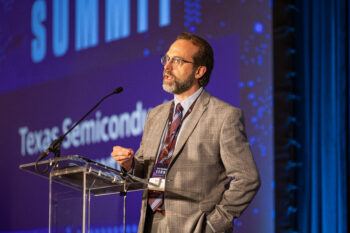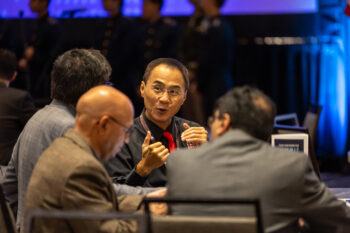Texas Semiconductor Summit Showcases the State’s Potential to Lead a Manufacturing Surge in the Semiconductor Industry
Technology experts, industry leaders, university officials and government representatives gathered on the Texas A&M University campus last week to discuss strategies for overcoming an ongoing semiconductor chip shortage.
The need for collaboration and innovation were key themes at the two-day Texas Semiconductor Summit, which drew more than 250 participants from about 40 companies and 25 universities, along with economic development organizations from around the state and representatives from the U.S. Department of Commerce, the National Security Agency and various national laboratories.
Dr. David Staack, interim director of the newly formed Texas A&M Semiconductor Institute, said the goal of the summit was to bring in various stakeholders to talk about initiatives and strategies to improve domestic manufacturing of semiconductors.

“These are in your smartphone, in your computer, in your car, in our communications systems, in our defense systems,” Staack said. “The semiconductor industry is incredibly important to everybody.”
Supply chain disruptions and the lack of semiconductor chip manufacturing in the United States pose economic and national security risks, speakers at the summit said. Staack said production of semiconductors in the U.S. has fallen to just 12% from 37% in 1990, and without intervention, would have continued to decline.
In 2022, Congress passed the U.S. CHIPS and Science Act, allocating $39 billion for facilities and equipment to increase national chip manufacturing and an additional $11 billion for research and development projects. In June, Texas Gov. Greg Abbott signed the Texas CHIPS Act, a nearly $1.4 billion investment to grow semiconductor manufacturing in the state.
Ayodele Okeowo, director of intergovernmental affairs for the CHIPS Programs Office in the U.S. Department of Commerce, said it was inspiring to see how Texas A&M was working with partners across the federal government and the state of Texas to identify strategies to revitalize semiconductor manufacturing.
“It’s going to be hard work. This is sort of a momentous occasion to bring together all of the key folks who are working to build up this semiconductor ecosystem,” Okeowo said. “We understand that the task ahead of us is a challenging one. It’s going to take something from everyone.”
The Texas A&M University System and its members, along with university, industry, nonprofit and government partners across Texas, are in position to meet the challenges facing the industry through workforce training and investment in research and development, Staack said.
“Starting last year, we were tasked by the Office of the Governor to lead Texas’ response to build a coalition of Texas industries, universities, workforce development groups and economic development groups to respond to both the Texas CHIPS Act and the federal CHIPS Act,” Staack said. “So, we’ve stood up the Texas A&M Semiconductor Institute.”
As part of the effort, The Texas A&M University System is revitalizing coursework and working to increase the number of students in degree plans related to the semiconductor industry.
“We’re also looking to do research and development,” Staack said. “We’re building new facilities, new programs and expanding our existing facilities.”
Universities are uniquely equipped to revitalize the semiconductor ecosystem, Staack said.
Texas A&M has the facilities and technology to support semiconductor research and development. And the university is filling workforce needs with its graduates. Texas A&M’s College of Engineering is one of the largest in the nation with 23,500 students enrolled in fall 2023. This past academic year, Texas A&M awarded over 11,700 degrees in STEM programs, which included 390 Ph.Ds.
“How can we engage our electrical, mechanical and chemical engineering departments, and our chemists and physicists in terms of the courses that they teach and in terms of the research they do to not just solve immediate needs but also put ourselves in a better place in the next decade?” Staack said.
Staack said he encourages students to recognize the opportunities and embrace the challenge of innovating the highest tech in the world.
“We need people to understand the impact these devices have on their lives, but also the importance that they contribute to it,” Staack said. “To understand, ‘I love my phone, but I’m going to help build them, too.’”

